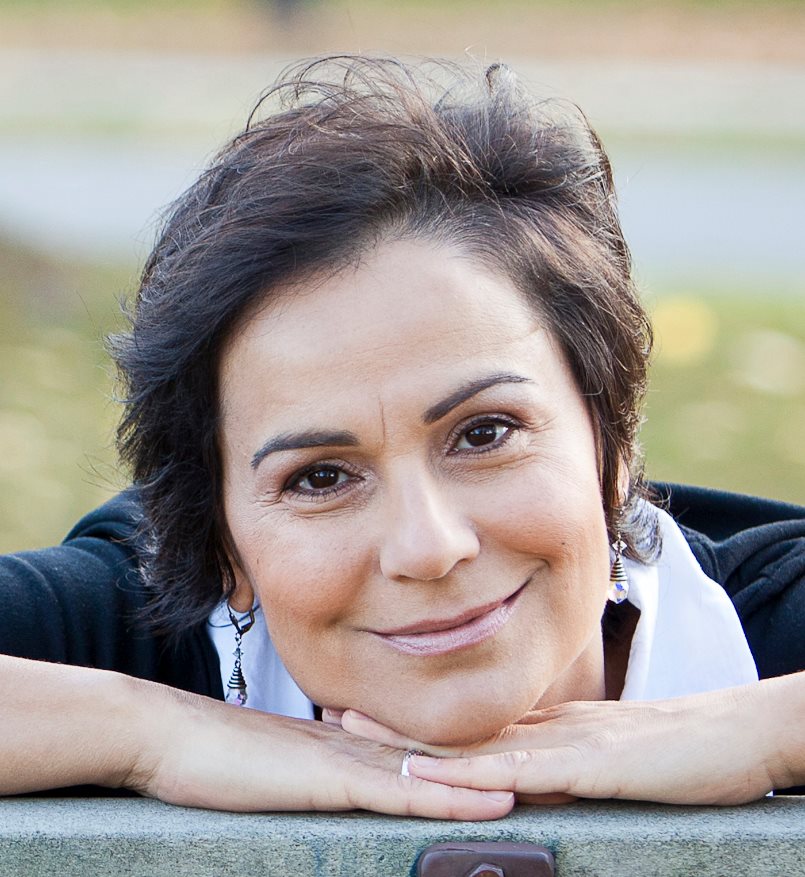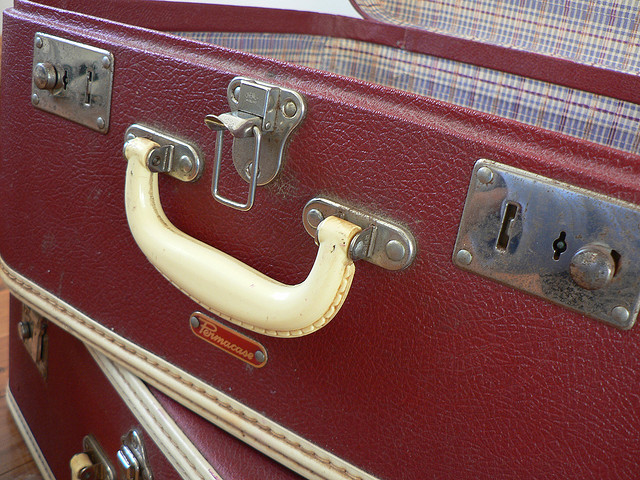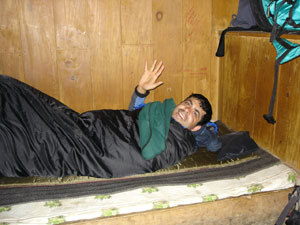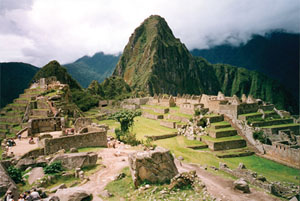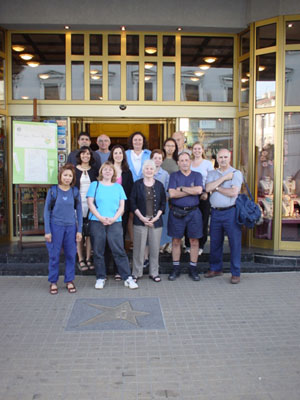5. Please tell us about the time leading up to your Walk for Peace. How did you decide on your route, what preparations did you undertake?
I started researching the Internet for ancient routes to Jerusalem, and found the web site of a 52-year old Dutch woman who had walked from The Hague to Jerusalem the year before. Her name was Johanna van Fessem. I sent her an email introducing myself and telling her about my plan. She responded right away and we struck up an immediate rapport by email. She told me she drew a straight line between her home in The Hague and Jerusalem, and then walked that route. She also told me about Jeanette Albers, another 50-year old Dutch woman who had walked from Amsterdam to Jerusalem the same year, but taking a different route. Jeanette had walked from Amsterdam to Bari (Italy), took a boat to Haifa (Israel), and then walked to Jerusalem. I already knew about Jeanette and had spoken to her briefly by telephone through some friends who knew her from the Camino to Santiago.
They both invited me to meet with them in Holland before starting my journey. I felt that would be the best preparation – to learn from the experiences of fellow pilgrims. It was now early October. I was still on the continent, so I packed up my backpack and booked my flight to Amsterdam. Johanna and Jeanette were both incredibly supportive of my walk and encouraged me to simply walk without worrying about the details. To just be open and let the Universe/God/the angels be my guide. That I was protected and would be led to where I needed to be. Their biggest advice to me was to simply trust the process that had led me this far. I felt very fortunate to have met them. In them, I had found two kindred spirits, two angels really, who were sent into my path to reassure me, to show me that I wasn’t alone, neither in my thinking nor in my intentions.
I also used my time in Amsterdam to buy equipment I thought I would need for walking in the winter such as a tent, warm sleeping bag, fleece sweater, wool socks, compass, and basic camping supplies (lightweight pot, plate, utensils, rope). Both Johanna and Jeanette had told me to pack light, so I was trying to buy as little as possible. They told me to buy my maps along the way and not be burdened with their weight. I also learned about a women’s outdoor survival weekend which was taking place while I was in Amsterdam. This felt like an incredible gift, as I had very little confidence in camping alone. In case I needed to do it, I wanted to feel prepared to camp out by myself. A week later, I was learning how to use my compass and read the stars, how to pitch my tent and start a fire in total darkness.
I decided that the Vatican in Rome would be my starting point. It symbolized the Heart, the centre of Love, and was a clear landmark. Although I didn’t walk the Way of the Heart to get there, I felt it was quite symbolic to be walking from the Heart and making my way to the Soul. For me, the Way of the Soul was about remembering who I really am, and living it. That my life isn’t simply about taking but giving. That we are all connected and what I do for others, I do for myself, and vice versa. By expressing that and sharing that with the world, my Soul is alive and living its True Purpose.

Mony in Turkey
6. Your walk started in Rome and you mentioned that Italy was your testing ground. Please tell us about your walking experience in Italy.
The first ten days of my pilgrimage I walked alone. I started walking on November 21, 2001 heading north in the direction of Assisi. My map only brought me to that point. I had the intention of walking towards the Adriatic coast, then northward to Venice and then down the other side of the Adriatic to Greece, then east towards Turkey, and the Middle East. I had no concrete plans, just a general idea.
I wanted to camp out my first night and put into practice my intentions to let go and trust. If I could camp out as a woman alone at night in a foreign country where I couldn’t speak the language, with all the unknowns of this journey still ahead of me, then I would be facing my fears directly. My deepest fear was that of being attacked, raped and possibly killed. No one knew exactly where I was. I had no firm plans. No one knew my exact route – I didn’t really have one. No one was waiting for me at the end of the day or calling me to make sure I arrived safely. If I disappeared, no one would find me. That was the deepest fear I wanted to confront. I did not want it to fester in hidden places within me, manifesting itself whenever and however it wanted. I camped out my first night and nothing happened. I slept blissfully until the following morning.
My first few days of walking were difficult. This wasn’t like walking the Camino to Santiago with beautifully marked trails and fields. I was walking on the open road with little or no sidewalk. I couldn’t find a natural rhythm and was spending a lot of energy watching the roads and the cars. I was walking facing the traffic and felt the wind and exhaust in my face all day. People were honking at me and gesturing at me from their cars. Things got better when I found the country roads where there were fewer cars and people.

Alberto in Israel
My greatest frustration and obstacle was communication. To my surprise, most people I met only spoke Italian. I spoke English, French, Arabic and a few words of Spanish. I communicated using a mix of English and Spanish, and a lot of sign language. I really couldn’t explain why I was walking and when I did, people just thought I was pretty strange. With my heavy backpack and walking boots, many people thought I was an ‘alpinista’- a hiker or mountaineer. I couldn’t correct them or explain anything to them. I had to be content with the silence.
But I was also met with a lot of hospitality and people who were genuinely interested in what I was doing and helped me along my way, either by helping me find accommodations or offering to buy me lunch or coffee, or simply to shake my hand and pat my shoulder, which meant more to me than they could ever imagine. It was those moments that kept me going and gave me confidence and faith that I was doing the right thing.
I had met a fellow pilgrim on the Camino to Santiago and when he heard about my plan to walk, felt drawn to walk it with me. His name was Alberto Agraso, from Cadiz Spain. I started from Rome alone and he joined me ten days later. On December 4, 2001 we started walking together from Rieti.
7. What about the practical considerations of this 5000 km walk? Where did you sleep? What did you eat? What was your daily routine like? How physically strenuous was it?
When I was walking alone, I stayed in hostels and when I couldn’t find them, I went to a monastery or church and asked for help. When Alberto started walking with me, he wanted to walk like pilgrims of old and preferred to go directly to monasteries and churches for help. Which is what we did in the end. Usually we started walking at around 8:00 in the morning, taking small breaks when we felt tired, stopping at cafes or bars in small towns when we found them.
We carried some food and water with us in case we couldn’t find an open café. We usually had cookies and often some bread. We normally walked between 20 and 25km a day. When we stopped for the day, we would find the church or monastery in town and ask for the priest or person in charge. We would explain that we were walking to Jerusalem for peace and only needed a roof over our heads for the evening. We didn’t need beds or showers. We could sleep on the floor. We explained we had sleeping bags, food and money, and would be gone in the morning. In the majority of cases, we were warmly welcomed.
Most times we slept on the floor or on a table in a church hall in our sleeping bags. Typically, there was no heat or hot water. But many times, we found beds and hot water and heating. When there was hot water and heaters we could shower and wash our clothes. Without hot water, we used baby wipes to wash ourselves. Often we were invited to eat by the priest which we always appreciated. Other times, we ate what we found in the supermarket – cheese, bread, mayonnaise, butter, pate in a tube, cookies. It all depended on the day and the size of the market we were in.
Other times still, we were invited into peoples’ homes and treated to a warm home-cooked meal. Those were the special occasions that meant a lot to us. In the evenings, we would write in our diaries and look at our map to decide the route for the next day. We would then roll out our foam mats and sleeping bags and sleep by 10:00. We woke up at around 7:00 the next morning, packed up our things, and had coffee with the priest or at the nearest café.
In the beginning, the walk was challenging because our packs were heavy, mine weighing about 17kg and Alberto’s over 20kg. We were carrying winter gear and tents. In the early weeks of our walk, we also were walking in the foothills of the Appenine Mountains on fairly challenging terrain. We both got walking sticks to help us support the weight of our backpacks, especially as we were going downhill. The only pain I felt was in my knees and ankles when going downhill. But our bodies became accustomed very quickly, remembering a similar pilgrimage only a few months earlier.

Mony and Alberto in Jerusalem
8. You also had a walking partner for the majority of this walk. Please tell us how that came about and how this relationship has developed.
I met Alberto in Finisterre, 100km west of Santiago de Compostela. He was in the company of a fellow pilgrim from Germany named Linda that I had walked almost the entire way with. I shared with them my idea about walking to Jerusalem. They were supportive but didn’t feel any strong attraction to do it. He spoke little English but I found out through Linda that he was from Cadiz in the south of Spain. He had left his job as an insurance adjustor at a large Spanish insurance company (MAPFRE) because he was feeling dissatisfied with his work and was trying to live a life with purpose. He loved to paint and sculpt, and was making his living from selling his work. It was a simple life but he was happy and always had enough. He was a deeply spiritual man and had gone through a spiritual transformation at the sudden death of his best friend in a construction accident. It made him reexamine his life and determine that he would live a life that was meaningful and contributing to something positive in the world.
We parted ways that same day. A few months later, in late October, on my way from Amsterdam to Rome to begin my walk, I stopped in Germany to see Linda and was surprised to see Alberto there. He had moved to Germany about a month earlier and was in a relationship with her. I was sharing with them my final plans for walking to Jerusalem, but this time something changed. Alberto told me he started receiving strong, indisputable signs that he needed to walk with me. He didn’t understand why, but the signs were persistent, appearing everywhere and in many forms. They were clear and he was sure about his interpretation of them. It was a difficult time for all of us. Linda had just started a new job and could not join us. She didn’t feel any real attraction to what I was doing, even though she supported it. In the end, Alberto made the difficult decision to leave the relationship and to follow what he believed to be his calling.
Our greatest challenge when we started walking was communication. He spoke little English, only what he had studied in school, and my Spanish was limited to the few words I had learned on the Camino. We spoke slowly using simple words and sentences, and lots of sign language, so we could understand each other. Eventually, we both learned to speak Italian and our conversations were usually a mix of English, Spanish, Italian and sign language. No one ever had a clue what we were saying or where we were from.
We started out as walking partners, pilgrims believing in the same cause, wanting to contribute to the fabric of peace in the world. For me in the beginning, I was walking for peace in Jerusalem. For him, it was peace in general, starting with inner peace and radiating out, like a pebble in a pond. After walking almost six months together and living through incredible experiences, many difficult and overwhelming, others of pure magic, our relationship developed from acquaintance to friendship and eventually to romance. He is now my husband and we live together in his hometown of Cadiz with our nineteen month old daughter Sylvana.
This is part one of Mony’s interview. Please stay tuned for the second part which will be completed over the next few weeks. Thank you, Mony, for so intimately sharing the story of your transformation with us. I look forward to hearing more about the phenomenal changes in your life.
